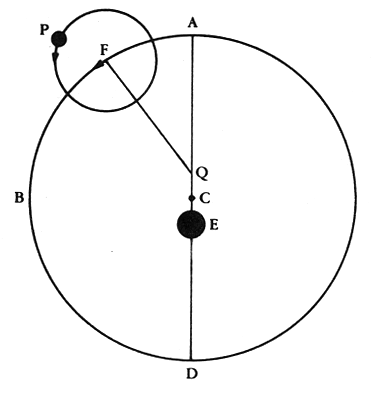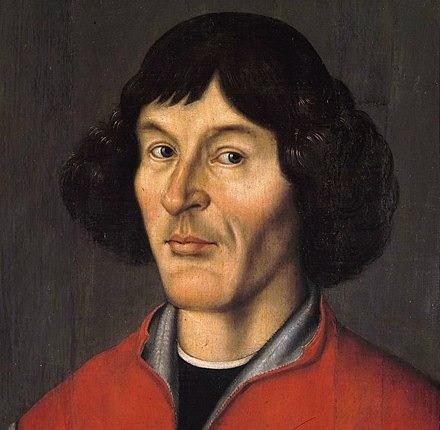The period from Copernicus to Newton is certainly one of the
richest and most important in the history of astronomy.
Material covering this period is plentiful and one of the
chief challenges for the casual historian of astronomy is
culling through the options and deciding what to read.
Certainly biographies figure high on the priority list.
Galileo and Newton have no shortage of books devoted to their
lives and work. Biographies of Copernicus are rare because
relatively little is known of his life. Kepler and Tycho fall
somewhere in the middle.
Ptolemaic System
http://en.wikipedia.org/wiki/Ptolemaic_system
http://galileo.rice.edu/sci/theories/ptolemaic_system.html
 Nicolas Copernicus
https://en.wikipedia.org/wiki/Nicolaus_Copernicus
http://www.phy.hr/~dpaar/fizicari/xcopern.html
When "On the Revolutions" appeared in 1543, it was attacked by
Protestant theologians who held the premise of a heliocentric
universe to be unbiblical. Copernicus' theories, they reasoned,
might lead people to believe that they are simply part of a
natural order, and not masters of nature, the center around
which nature was ordered.
Because of clerical opposition, and perhaps also general
incredulity at the prospect of a non-geocentric universe,
between 1543 and 1600, fewer than a dozen scientists embraced
Copernican theory.
But among those "scientists" being influenced by Copernicus'
Sun centered cosmology where Tycho Brahe, Johannas Kepler and
Galileo Galilei.
Nicolas Copernicus
https://en.wikipedia.org/wiki/Nicolaus_Copernicus
http://www.phy.hr/~dpaar/fizicari/xcopern.html
When "On the Revolutions" appeared in 1543, it was attacked by
Protestant theologians who held the premise of a heliocentric
universe to be unbiblical. Copernicus' theories, they reasoned,
might lead people to believe that they are simply part of a
natural order, and not masters of nature, the center around
which nature was ordered.
Because of clerical opposition, and perhaps also general
incredulity at the prospect of a non-geocentric universe,
between 1543 and 1600, fewer than a dozen scientists embraced
Copernican theory.
But among those "scientists" being influenced by Copernicus'
Sun centered cosmology where Tycho Brahe, Johannas Kepler and
Galileo Galilei.
 Copernicus (1473-1543)
|
|
___________________________________________________
Tycho Brahe Johannas Kepler Galileo Galilei
(1546-1601) (1571-1630) (1564-1642)
It was Copernicus' little book that really got the revolution
going. Isaac Newton would eventually put it all together in
his Principia, giving us Classical Mechanics, and a theory of
gravitation that worked in the heavens the same as on Earth.
Copernicus (1473-1543)
|
|
___________________________________________________
Tycho Brahe Johannas Kepler Galileo Galilei
(1546-1601) (1571-1630) (1564-1642)
It was Copernicus' little book that really got the revolution
going. Isaac Newton would eventually put it all together in
his Principia, giving us Classical Mechanics, and a theory of
gravitation that worked in the heavens the same as on Earth.
 Copernican Principle
https://en.wikipedia.org/wiki/Copernican_principle
The Copernican Principle is a basic statement in physics
that there should be no "special" observers. For example,
the Aristotelian model of the solar system in the Middle
Ages placed the Earth at the center of the solar system, a
unique place since it "appears" that everything revolved
around the Earth. Nicolaus Copernicus demonstrated that this
view was incorrect and that the Sun was at the center of the
solar system with the Earth in orbit around the Sun.
The implications of Copernicus' work can not be exaggerated.
His views challenged the literal interpretation of
Scripture, the philosophical and metaphysical foundations of
moral theory, and even common sense itself. The result was a
massive opposition to his reported ideas. It was the slow,
sure acceptance of the heliocentric theory by natural
philosophers that ultimately quieted the general clamor,
however the name of Copernicus is still a battle cry against
the establishment in religion, philosophy and science. In
later years with Freud, man lost his Godlike mind; with
Darwin his exalted place among the creatures of the Earth;
with Copernicus man had lost his privileged position in the
Universe.
Proof that the Earth goes around the Sun
https://en.wikipedia.org/wiki/Foucault_pendulum
https://en.wikipedia.org/wiki/Aberration_of_light
On The Revolutions of Heavenly Spheres
by Nicolaus Copernicus [and Stephen Hawking]
Running Press December 2004
ISBN-13: 9780762420216
ISBN-10: 0762420219
https://www.amazon.com/Revolutions-Heavenly-Spheres-Shoulders-Giants/dp/0762420219
New to our On the Shoulders of Giants series, this
groundbreaking work of astronomy proposed a heliocentric
universe in which planets orbited the sun-daring to
challenge the Ptolemaic ideal of the earth as the center of
the universe. This essay by Copernicus (1473-1543),
revolutionized the way we look at the earth's placement in
the universe, and paved the way for many great scientists,
including Galileo and Isaac Newton, whose theories stemmed
from this model. Featuring a biography of Copernicus and an
accessible, enlightening introduction, both written by the
renowned physicist Stephen Hawking, On the Revolution of
Heavenly Spheres provides a fascinating look at the theories
which shaped our modern understanding of astronomy and
physics.
The Book Nobody Read: Chasing the Revolutions of Nicolaus
Copernicus
by Owen Gingerich
Walker Books, March 2004
ISBN-13: 9780802714152
ISBN-10: 0802714153
https://www.amazon.com/Book-Nobody-Read-Revolutions-Copernicus/dp/B000BNPG8C
"In one of the most unusual stories I have ever read,
Gingerich recreates the history of thought in sixteenth and
seventeenth century Europe from notes scribbled in the
margins of several hundred copies of a great book. The
account of his academic sleuthing is a treasure of
information, intellectual history, and personal passion."
~Alan Lightman
Uncentering the Earth: Copernicus and The Revolutions of the
Heavenly Spheres
by William T. Vollmann
Norton, February 2006
ISBN-13: 9780393059694
ISBN-10: 0393059693
https://www.amazon.com/Uncentering-Earth-Copernicus-Revolutions-Discoveries/dp/B001TZENI0
"This book itself is uncentering in the best possible way.
Vollmann is one of the deepest, most fully ensouled writers
alive."
~David Foster Wallace
sam.wormley@icloud.com
Copernican Principle
https://en.wikipedia.org/wiki/Copernican_principle
The Copernican Principle is a basic statement in physics
that there should be no "special" observers. For example,
the Aristotelian model of the solar system in the Middle
Ages placed the Earth at the center of the solar system, a
unique place since it "appears" that everything revolved
around the Earth. Nicolaus Copernicus demonstrated that this
view was incorrect and that the Sun was at the center of the
solar system with the Earth in orbit around the Sun.
The implications of Copernicus' work can not be exaggerated.
His views challenged the literal interpretation of
Scripture, the philosophical and metaphysical foundations of
moral theory, and even common sense itself. The result was a
massive opposition to his reported ideas. It was the slow,
sure acceptance of the heliocentric theory by natural
philosophers that ultimately quieted the general clamor,
however the name of Copernicus is still a battle cry against
the establishment in religion, philosophy and science. In
later years with Freud, man lost his Godlike mind; with
Darwin his exalted place among the creatures of the Earth;
with Copernicus man had lost his privileged position in the
Universe.
Proof that the Earth goes around the Sun
https://en.wikipedia.org/wiki/Foucault_pendulum
https://en.wikipedia.org/wiki/Aberration_of_light
On The Revolutions of Heavenly Spheres
by Nicolaus Copernicus [and Stephen Hawking]
Running Press December 2004
ISBN-13: 9780762420216
ISBN-10: 0762420219
https://www.amazon.com/Revolutions-Heavenly-Spheres-Shoulders-Giants/dp/0762420219
New to our On the Shoulders of Giants series, this
groundbreaking work of astronomy proposed a heliocentric
universe in which planets orbited the sun-daring to
challenge the Ptolemaic ideal of the earth as the center of
the universe. This essay by Copernicus (1473-1543),
revolutionized the way we look at the earth's placement in
the universe, and paved the way for many great scientists,
including Galileo and Isaac Newton, whose theories stemmed
from this model. Featuring a biography of Copernicus and an
accessible, enlightening introduction, both written by the
renowned physicist Stephen Hawking, On the Revolution of
Heavenly Spheres provides a fascinating look at the theories
which shaped our modern understanding of astronomy and
physics.
The Book Nobody Read: Chasing the Revolutions of Nicolaus
Copernicus
by Owen Gingerich
Walker Books, March 2004
ISBN-13: 9780802714152
ISBN-10: 0802714153
https://www.amazon.com/Book-Nobody-Read-Revolutions-Copernicus/dp/B000BNPG8C
"In one of the most unusual stories I have ever read,
Gingerich recreates the history of thought in sixteenth and
seventeenth century Europe from notes scribbled in the
margins of several hundred copies of a great book. The
account of his academic sleuthing is a treasure of
information, intellectual history, and personal passion."
~Alan Lightman
Uncentering the Earth: Copernicus and The Revolutions of the
Heavenly Spheres
by William T. Vollmann
Norton, February 2006
ISBN-13: 9780393059694
ISBN-10: 0393059693
https://www.amazon.com/Uncentering-Earth-Copernicus-Revolutions-Discoveries/dp/B001TZENI0
"This book itself is uncentering in the best possible way.
Vollmann is one of the deepest, most fully ensouled writers
alive."
~David Foster Wallace
sam.wormley@icloud.com
Nicolas Copernicus https://en.wikipedia.org/wiki/Nicolaus_Copernicus http://www.phy.hr/~dpaar/fizicari/xcopern.html When "On the Revolutions" appeared in 1543, it was attacked by Protestant theologians who held the premise of a heliocentric universe to be unbiblical. Copernicus' theories, they reasoned, might lead people to believe that they are simply part of a natural order, and not masters of nature, the center around which nature was ordered. Because of clerical opposition, and perhaps also general incredulity at the prospect of a non-geocentric universe, between 1543 and 1600, fewer than a dozen scientists embraced Copernican theory. But among those "scientists" being influenced by Copernicus' Sun centered cosmology where Tycho Brahe, Johannas Kepler and Galileo Galilei.
Copernicus (1473-1543) | | ___________________________________________________ Tycho Brahe Johannas Kepler Galileo Galilei (1546-1601) (1571-1630) (1564-1642) It was Copernicus' little book that really got the revolution going. Isaac Newton would eventually put it all together in his Principia, giving us Classical Mechanics, and a theory of gravitation that worked in the heavens the same as on Earth.
Copernican Principle https://en.wikipedia.org/wiki/Copernican_principle The Copernican Principle is a basic statement in physics that there should be no "special" observers. For example, the Aristotelian model of the solar system in the Middle Ages placed the Earth at the center of the solar system, a unique place since it "appears" that everything revolved around the Earth. Nicolaus Copernicus demonstrated that this view was incorrect and that the Sun was at the center of the solar system with the Earth in orbit around the Sun. The implications of Copernicus' work can not be exaggerated. His views challenged the literal interpretation of Scripture, the philosophical and metaphysical foundations of moral theory, and even common sense itself. The result was a massive opposition to his reported ideas. It was the slow, sure acceptance of the heliocentric theory by natural philosophers that ultimately quieted the general clamor, however the name of Copernicus is still a battle cry against the establishment in religion, philosophy and science. In later years with Freud, man lost his Godlike mind; with Darwin his exalted place among the creatures of the Earth; with Copernicus man had lost his privileged position in the Universe. Proof that the Earth goes around the Sun https://en.wikipedia.org/wiki/Foucault_pendulum https://en.wikipedia.org/wiki/Aberration_of_light On The Revolutions of Heavenly Spheres by Nicolaus Copernicus [and Stephen Hawking] Running Press December 2004 ISBN-13: 9780762420216 ISBN-10: 0762420219 https://www.amazon.com/Revolutions-Heavenly-Spheres-Shoulders-Giants/dp/0762420219 New to our On the Shoulders of Giants series, this groundbreaking work of astronomy proposed a heliocentric universe in which planets orbited the sun-daring to challenge the Ptolemaic ideal of the earth as the center of the universe. This essay by Copernicus (1473-1543), revolutionized the way we look at the earth's placement in the universe, and paved the way for many great scientists, including Galileo and Isaac Newton, whose theories stemmed from this model. Featuring a biography of Copernicus and an accessible, enlightening introduction, both written by the renowned physicist Stephen Hawking, On the Revolution of Heavenly Spheres provides a fascinating look at the theories which shaped our modern understanding of astronomy and physics. The Book Nobody Read: Chasing the Revolutions of Nicolaus Copernicus by Owen Gingerich Walker Books, March 2004 ISBN-13: 9780802714152 ISBN-10: 0802714153 https://www.amazon.com/Book-Nobody-Read-Revolutions-Copernicus/dp/B000BNPG8C "In one of the most unusual stories I have ever read, Gingerich recreates the history of thought in sixteenth and seventeenth century Europe from notes scribbled in the margins of several hundred copies of a great book. The account of his academic sleuthing is a treasure of information, intellectual history, and personal passion." ~Alan Lightman Uncentering the Earth: Copernicus and The Revolutions of the Heavenly Spheres by William T. Vollmann Norton, February 2006 ISBN-13: 9780393059694 ISBN-10: 0393059693 https://www.amazon.com/Uncentering-Earth-Copernicus-Revolutions-Discoveries/dp/B001TZENI0 "This book itself is uncentering in the best possible way. Vollmann is one of the deepest, most fully ensouled writers alive." ~David Foster Wallace sam.wormley@icloud.com